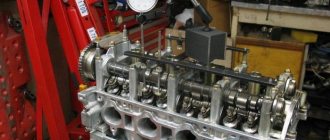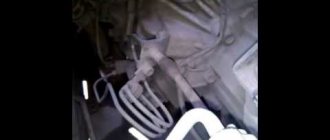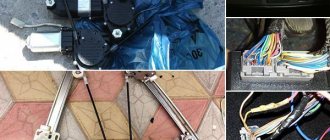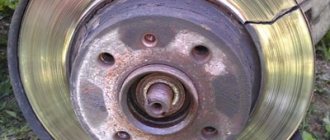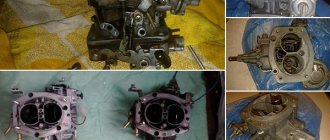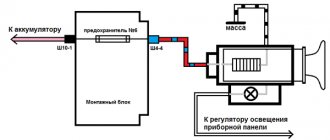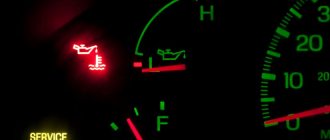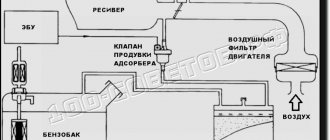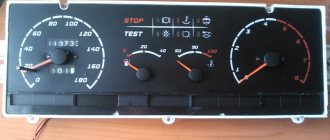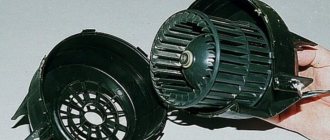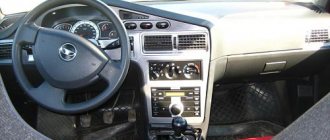If 1 cylinder does not work for you, then do not worry, this happens very often and for this reason it has received new names “ Trouble engine ” or “Missing” among car owners. In Soviet times, cars had four cylinders and when one of them did not work, people managed to drive a car with three cylinders. This type of driving is called “troit”.
Video of cylinder operation diagnostics:
Modern cars have from 3 to 12 cylinders, but the former name for this phenomenon has not lost its relevance and is used to this day. If the first cylinder does not work, then this is easy to notice by an unfamiliar sound constantly emanating from the car, interruptions in engine operation and unpleasant vibration of the body.
Of course, you can drive with one cylinder damaged; you have other good ones, but this is quite dangerous, both for the engine, which wears out quickly and will require expensive repairs, and for the life of the driver.
Driving with an inoperative cylinder leads to the fact that the fuel in the faulty cylinder does not burn and, mixed with oil, enters the crankcase, where it damages the cylinder walls and does not perform its main function - lubrication of the remaining cylinders.
Signs of engine tripping
Troubleshooting is usually called the failure of one or more cylinders. This is due to the widespread use of four-cylinder automobile engines in the USSR and the disregard for their maintenance, which gave rise to the failure of individual cylinders with subsequent blame for the problems of Soviet technology.
In fact, five, six, or eleven can remain working, depending on which engine and which car. But the signs are similar in all cases:
- the appearance of noticeable vibration from the engine, it can be quite comfortable, but was previously absent;
- characteristic ragged notes appear in the sound of the engine, as the absolutely uniform sequence of flashes has changed to a more complex and arrhythmic one;
- if you attach a piece of paper to the exhaust pipe, you will notice how it twitches in time with every fourth portion of the exhaust gases (if there are still four cylinders);
- The “Check Engine” indicator light on the dashboard will definitely come on, which means that the electronic engine control unit (ECU) has detected a problem.
Self-diagnosis built into the ECU can guess the source of the malfunction, but more often it is necessary to carry out a more complex search using diagnostic equipment.
No compression
The absence of compression (or its low value) indicates wear of the engine mechanisms. The reasons for the complete lack of compression can be:
Incorrectly adjusted valve clearances. If there is no gap, this indicates that the valve is “clamped” and is always in the open position. If the valve is clamped and the gaps cannot be reduced, this may indicate “sagging” valve seats.
Valve burnout. Gas-powered vehicles are especially susceptible to this and have incorrectly adjusted valves.
Burnout of the cylinder head gasket. Burnout of the gasket may be accompanied by the “disappearance” of coolant from the cooling system and the appearance of white smoke from the exhaust pipe.
Occurrence of piston rings. Typically, the rings become stuck after the engine overheats, when the oil burns out, and the rings stick into the recesses in the pistons.
A low compression value indicates natural wear of the rings and cylinder-piston group. The exact cause of the drop in compression can only be identified after opening the cylinder head.
Causes of malfunction
If we remember the theory, then for a flash and a power stroke, you need to feed the mixture into the combustion chamber in the required quantity, compress it and set it on fire at a precisely defined moment. Based on this, you can think about possible reasons why this does not happen.
Mechanical breakdowns
For successful ignition, the fuel-air mixture must be well compressed. But if the engine has lost compression, for example, as a result of wear of the pistons, rings or burnt-out valves, and this did not happen in all cylinders at the same time, which is unlikely, then it will just tune up. You'll have to take a pressure gauge and check the compression.
On the subject: Why does a diesel engine bleed and what to do
Mechanical problems may also include problems with the gas distribution mechanism, which will lead to disruptions in the flow of the mixture. But this is unlikely to happen with a separate cylinder and without loss of compression.
Supply system
There are many components and parts in it, but most of them relate to all engine cylinders. Only fuel injectors operate separately, so failure of one of them will lead to disruption of the stability of flashes specifically over a single piston.
The reasons may vary. Most often this is valve wear or clogged nozzles. The injector stops accurately dosing gasoline, and for it to ignite reliably, it must be mixed with air in a fairly accurately standardized proportion. When this is not done, the gasoline does not burn, the flash occurs, and the engine twitches.
When operating for a long time in this mode, the ECU will begin to rescue the faulty cylinder and completely turn off the injector in it. Otherwise, gasoline will wash away the oil from the walls, causing wear and scuffing.
Ignition system
Here, each cylinder of a modern engine usually has a separate spark plug and ignition coil. Failure of both will have exactly the same results - the cylinder will turn off.
There are engines with more ancient principles of organizing the final devices of the ignition system. In particular, one coil per pair of cylinders. If it fails, of course, the flashes will disappear in two at once, the engine will twitch much more strongly, and most likely it will simply stall.
Irregular tripping under load
The most difficult thing will be in the case when interruptions occur when opening the throttle and accelerating the car. That is, the parts have not yet completely failed, but are just unable to provide the load conditions. Diagnosis will be difficult; the experience of the master will tell you a lot.
By analyzing the ECU data, he can prepare a version and then test it practically. For example, if a spark plug partially fails, its gap will normally break through at low pressure in the cylinder and a lean mixture. But during acceleration, the conditions for a successful breakdown become more stringent, and the spark plug fails.
The technician can study the oscillogram data of the secondary ignition circuit, or he can simply pay attention to the appearance of the spark plugs.
“Trouble engine” - what is it?
When they say “the engine is trembling,” they mean that one or even several cylinders in the engine have begun to work poorly or have completely stopped participating in the engine’s operation. That is, the fuel-air mixture has stopped burning in them. It is very easy to understand that the car’s engine has begun to “trouble.” In this operating mode, the engine begins to shake noticeably, and vibration from it is transmitted to the car body. Usually, the “triple” of the engine is accompanied by the fact that it stops “pulling” the car, since it does not have enough power. In this article we will even consider those malfunctions due to which I cannot even work fully all the cylinders at once, and not just one or two.
How to check which cylinder is not working
The easiest way is to look into the ECU error memory using a scanner and diagnostic program. It will indicate how many misfires occurred and in which cylinder.
Unfortunately, this data is not always accurate. The dip counter is not always precisely synchronized with the timing disc on the crankshaft pulley, so it can point to the faulty cylinder.
But this is easy to check; just remove the connector from the injector. On a faulty cylinder, this will not affect the operation of the engine in any way, but if the working one is turned off, the engine will “limp” much more.
Ignition system
After identifying a bad cylinder, it is necessary to unscrew the spark plugs and inspect them. When the spark plug is working properly, its side electrode should not have heavy carbon deposits, and its color should be light and slightly brown. If there is black carbon on the spark plug, this indicates that the spark plug was filled with a large amount of gasoline or oil.
The candle body itself should be white and there should be no colored (usually brown or black) stripes or dots on it. Their presence indicates that the candle is “breaking” and is not able to work properly.
The spark plug is checked as follows: the spark plug is unscrewed from the engine, inserted into the tip of the spark plug wire and placed on any metal part of the engine (this will serve as a “ground”). An assistant should turn the engine with the starter, and another person should look at the spark strength on the spark plugs. If the spark is weak or completely absent, then it is better to replace the “non-working” spark plug with a working spark plug. If this time the working spark plug suddenly stops working (and the non-working spark plug starts working), then the problem is in the wire, distributor or coil. The spark plug wires can also be checked. This is done as follows. First, they are visually inspected for damage. If everything looks good, you need to measure the resistance of the wires with a multimeter, it should be about 20 ohms. If the value is different, then the wire needs to be sent for replacement.
What does driving with an inoperative engine cylinder lead to?
When a cylinder fails, the fuel mixture entering it does not burn. The fuel is mixed with oil, removing it from the cylinder bore. The mixture will then penetrate into the crankcase. Due to the fact that the surface of the cylinder is dry, scoring occurs on it. In addition, oil mixed with fuel does not lubricate healthy cylinders well.
As a result of the failure of the first cylinder, the others will also stop working normally. Where will all this lead? The car owner will be forced to spend a large sum on boring the cylinder block or even on lining.
The next problem that will happen if the cylinder fails is that the engine will overheat. The change in its operating temperature is due to the fact that the lubricant does not perform its functions. And, as you know, motor oil not only lubricates surfaces, but also removes heat.
All of the above is sufficient reason to declare: under no circumstances should you operate a car after a cylinder failure!
What happens if you ignore cylinder failure?
It is not advisable to drive without one cylinder. But you shouldn’t turn to the services of a tow truck because of this either. You can also get to the repair site using the remaining ones.
Some engines will quickly take care of shutting down the faulty cylinder for preventive purposes. But you shouldn’t hope for this, the ECU is quite capable of confusing and turning off the working one, or maybe not completely shutting off the gasoline.
Therefore, it is better to remove the connector from the injector yourself. If it does not “flow” when closed, this will save the cylinder walls from premature abrasion by dry rings.
There are engines where it is very difficult to turn off the fuel supply to a faulty cylinder. This type of car is best repaired on site.
Not only is driving with unburned gasoline washing the pistons fraught with scuffing, but if fuel gets into the crankcase, it kills all the characteristics of the engine oil. Overheating and rotation of the liners will end very badly. It is better to fix the problem or use a tow truck.
Source
Messages 14
1 Topic by kostya.ishekov93 2014-09-05 16:12:56
- kostya.ishekov93
- New member
- Inactive
- Registration: 2014-08-04
- Messages: 28 Thanks : 3
- Auto: 2110
Topic: Resolved: The 1st cylinder does not work, there is a spark
The 1st cylinder does not work. VV is normal, new, there is a spark. The injectors are new. There is compression) what is the problem? 2110 16 valves
2 Reply from igorek 2014-09-05 16:20:03 (2014-09-05 16:24:52 edited by igorek)
- igorek
- Brother-in-law
- Inactive
- From: Bryansk region g Starodub
- Registration: 2013-05-05
- Messages: 416 Thanks : 191
- Car: VAZ-21102 1.5i-8V Bosch MP7.0H
Re: Resolved: The 1st cylinder does not work, there is a spark
kostya.ishekov93 , 1st spark plug 2nd high-voltage coil. 3rd ignition module 4th injector control circuit. Is this all normal? and checked? If everything is normal, you can sin on the computer
3 Reply from kostya.ishekov93 2014-09-05 17:30:13 (2014-09-05 17:40:05 edited by kostya.ishekov93)
- kostya.ishekov93
- New member
- Inactive
- Registration: 2014-08-04
- Messages: 28 Thanks : 3
- Auto: 2110
Re: Resolved: The 1st cylinder does not work, there is a spark
kostya.ishekov93 , 1st spark plug 2nd high-voltage coil. 3rd ignition module 4th injector control circuit. Is this all normal? and checked? If everything is normal, you can sin on the computer
I checked the spark plug. I don’t have a coil, but a module) How can I check the module, or how can I understand what’s not working properly? The chain, as I understand it, if it were acting up, the check would show) The only error the check gives is 0301 Misfire in cylinder 1
Where to look for the cause of a non-working cylinder
The remark is that the check and search for the cause are carried out in a garage. There are two options: mechanical and electrical (ignition). You need to start taking the easy path, namely with ignition diagnostics.
- Spark plug. We determine their performance the old fashioned way. Visually, the side electrode and insulator should be light brown, but not black with soot flakes. A sooty electrode indicates either that the mixture is too rich or that it is splashed with oil. Sparking. Having inserted the spark plug into the explosive wire, bring it at a distance of 1-2 cm to the cylinder block and crank it with the starter. If the spark “jumps” this distance, then the spark plug is ok, if not, then we change it.
- High voltage wires. We check them for mechanical damage. We check their tips. If there is a light gray coating on the tip of the explosive wire, this indicates its operation in extreme mode. The resistance of explosive wires is checked with a multimeter. Different engines have different lengths of explosive wires and different resistances. Unless otherwise stated, 20 Kom is considered to be a constant resistance value. If the resistance is higher, you need to look for the cause in the explosive wire.
- Distributor. If the spark plug is faulty, then we will see a “breakdown” in the ignition distributor cap. Be sure to check the “coal”, you can stretch the spring a little.
- The explosive wires are simply mixed up. And it is precisely because of this that one or two cylinders do not work.
Next we move on to mechanics.
- Injector. It is quite possible that one cylinder is not working due to problems with the injector. This is either a malfunction of the injector itself, or the injector is clogged with low-quality fuel, or rather, because there is a lot of fuel in it. By the way, be careful and picky when using the “super-miracle” fuel purifiers that are sold on every corner. Ideally, diagnostics and cleaning of injectors should be carried out on a bench.
- Timing belt Fuel - the air mixture enters the cylinders in the wrong quantity and quality. There are a lot of reasons here. The belt is installed incorrectly, the tensioners are worn out, the seal is worn out. The camshaft is worn out, hydraulic compensators are worn out. A blown cylinder head gasket is usually due to engine overheating (look carefully at yourself when you want to ask why it overheated) during sporty driving, or a decrease in coolant level.
These are the traditional reasons why one cylinder of the engine does not work. And this is still an incomplete list. In any case, searching for the cause will lead you to the desired result, and you will eliminate this malfunction. On your own or with the help of a service.
Good luck identifying the cause and correcting the failed cylinder.
Home →
Practical advice →
Malfunctions →
